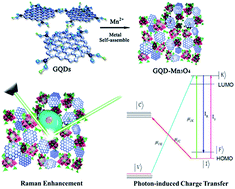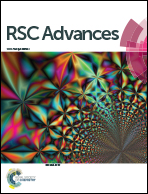Self-assembled nanoporous graphene quantum dot-Mn3O4 nanocomposites for surface-enhanced Raman scattering based identification of cancer cells†
Abstract
Surface-enhanced Raman scattering (SERS) as an unequivocal surface-sensitive technique has been considered one of the most powerful tools for identifying molecular species. However, the SERS active substrates have mainly been confined to some research on noble metals such as Pd, Au, Ag and Cu. In the present study, we describe the self-assembly of graphene quantum dots (GQDs) with Mn3O4, and the use of the resulting nanocomposite in the signal enhancement of Raman spectroscopy for non-noble metal SERS active substrates. GQDs can be used to enhance the Raman signal via an electromagnetic mechanism, but their intrinsic fluorescence overlaps with the Raman signal. Previous studies regarding tuning the energy level and energy gap to change the optical properties of GQDs mainly focused on doping heteroatoms. Assembling Mn3O4 with GQDs in nanocomposites can change the energy level of the material, and quench the fluorescence of the GQDs and adsorbed molecules to improve the Raman signal and noise. The large enhancement factor of 2.06 × 104, compared to that of graphene and graphene oxide, can be explained using a photon-induced charge transfer resonance model, which means that it not only can be used in small molecule identification but can also be used to discriminate cancer cells and normal cells.



 Please wait while we load your content...
Please wait while we load your content...